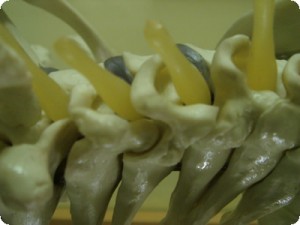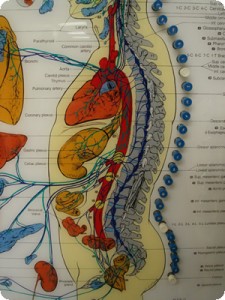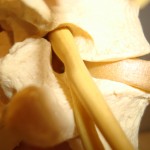A short list of some commonly used chiropractic terms in case you have any questions.
- Adjustment
- A form of manipulation, where the application of force is of a high velocity, low amplitude thrust. This type of manipulation can be likened to quickly pulling an apple off of a branch to obtain the specific apple, as opposed to pulling the apple slowly and obtaining multiple apples.
- Arthritis
- A general term referring to a condition of the joints. Literally it refers to an inflammation of the joints. There are many types of arthritides. The form which will inflict many people as they age is known as osteoarthritis. Other types include rheumatoid and psoriatic arthritis.
- Brain
- This is the portion of the Central Nervous system where higher mental and body functions occur. It is protected by the skull at the top of the head, and makes a smooth transition into the spinal cord at its base.
- Cervical
- When discussing the spinal column, this refers to the region of the neck.
- Chiropractor
- A doctor trained in the science, art, and philosophy of manipulation (adjustment) of the human body. Chiropractic evaluation and treatment is directed at evaluating the cause of the problem through structural analysis of the musculo-skeletal systems of the body. Abnormal function of these systems can lead to abnormal function of the body’s nervous system, which in turn may effect function of other systems in the body. Treatment is then rendered with the goal of restoring normal function via manipulating (adjusting) areas exhibiting abnormal structure.
- Chiropractic Subluxation Complex
- An extension of Joint Dysfunction. At this point, symptoms arise which are no longer simply musculo-skeletal. Now, through faulty transmission of information through the nervous system, various organs (heart, liver, stomach, etc) may malfunction.
- Degeneration
- A wear and tear phenomena. When the joints of the body wear out, it is referred to as osteoarthritis, also known as degenerative joint disease.
- Herniation
- Condition of the intervertebral disc, whereby some of the material which makes up the disc shifts to a position which irritates the nearby nerve for that spinal area.
- Intervertebral disc
- This is the soft tissue found between the bones of the spinal column, (i.e., the vertebrae). They help cushion the spine from everyday stress (i.e., running, walking, jumping, etc.). Through improper posture (i.e., bending forward at the waist and twisting), discs can wear out (degenerate). This can lead to the condition known commonly by the laymen, as a “slipped disc”, or a disc herniation.
- Joint
- The area between two bones where movement occurs. If movement is abnormal, pain and degeneration may occur.
- Joint dysfunction
- A condition whereby the joints of a particular area are not moving properly. Any sort of physical trauma may bring this about, along with proposed chemical or mental causes.
- Lumbar
- When discussing the spinal column, this refers to the region of the low back.
- Manipulation
- This is a form of manual therapy where an application of forces to structures such as muscles, joints, and bones is presented, where the goal is the restoration of normal joint motion and the elimination of pain secondary to disturbed biomechanics. (Manip #1 p. 280.)
Grieve mentions Korr’s definition of manipulation as follows: “the application of an accurately determined and specifically directed manual force to the body, in order to improve mobility in areas that are restricted; in joints, in connective tissues or in skeletal muscles”. (Manip #2 p. 857.) - Manual Therapy
- To work with one’s hands.
- Massage
- This is the application, usually by hand, of systematic stroking or manipulation to the soft tissues of the body for therapeutic purposes, i.e., to alleviate pain and discomfort. The most well known massage movements are those that involve stroking and gliding (effleurage), kneading (petrissage), and percussion (tapotement) to soft tissues of the body. (Manip #1 p. 286-289.)
- Nervous System
- The telephone communication center of the body. All information from outside the body and from inside the body must pass through this system. The two parts of the nervous system include the Central and Peripheral Nervous systems.
- Nerves
- The extensions which branch off of the brain and spinal cord and carry information to all parts of the body.
- Osteoarthritis
- Also known as degenerative joint disease. A form of arthritis in which a wear and tear phenomena occurs at the joint. A common form of arthritis, especially in older people.
- Range-Of-Motion
- This is a description for the amount of movement which occurs at a particular joint or region of the body, such as the lumbar spine. In the spinal column, there are six (6) different movements which may occur. These include flexion (bending forward), extension (bending backward), rotation (twisting right and left), and lateral flexion (bending to each side, right, and left).
- Spinal Column
- The bones of the back. The spinal column protects the spinal cord and allows for movement of the body in various ranges of motion. There are 24 movable bones (also known as vertebrae), plus a sacrum and a coccyx at the bottom of this column which is surrounded by the bony pelvis.

- Spinal Cord
- The extension of the brain. Coming off of the spinal cord are 31 pairs of spinal nerves which communicate with the body as a whole. The spinal cord is protected by the Spinal Column.
- Spondylolysis
- A degeneration of the intervertebral disc.
- Symptom
- The feeling, perceived by a patient, that something is not right.
- Thoracic
- When discussing the spinal column, this refers to the region of the back between the neck and the pelvis.
- Vertebrae
- The bones of the spinal column. There are three (3) areas of vertebrae: a cervical, thoracic, and lumbar area. The sacrum and coccyx are located underneath the lumbar region and are surrounded by the bony pelvis.

